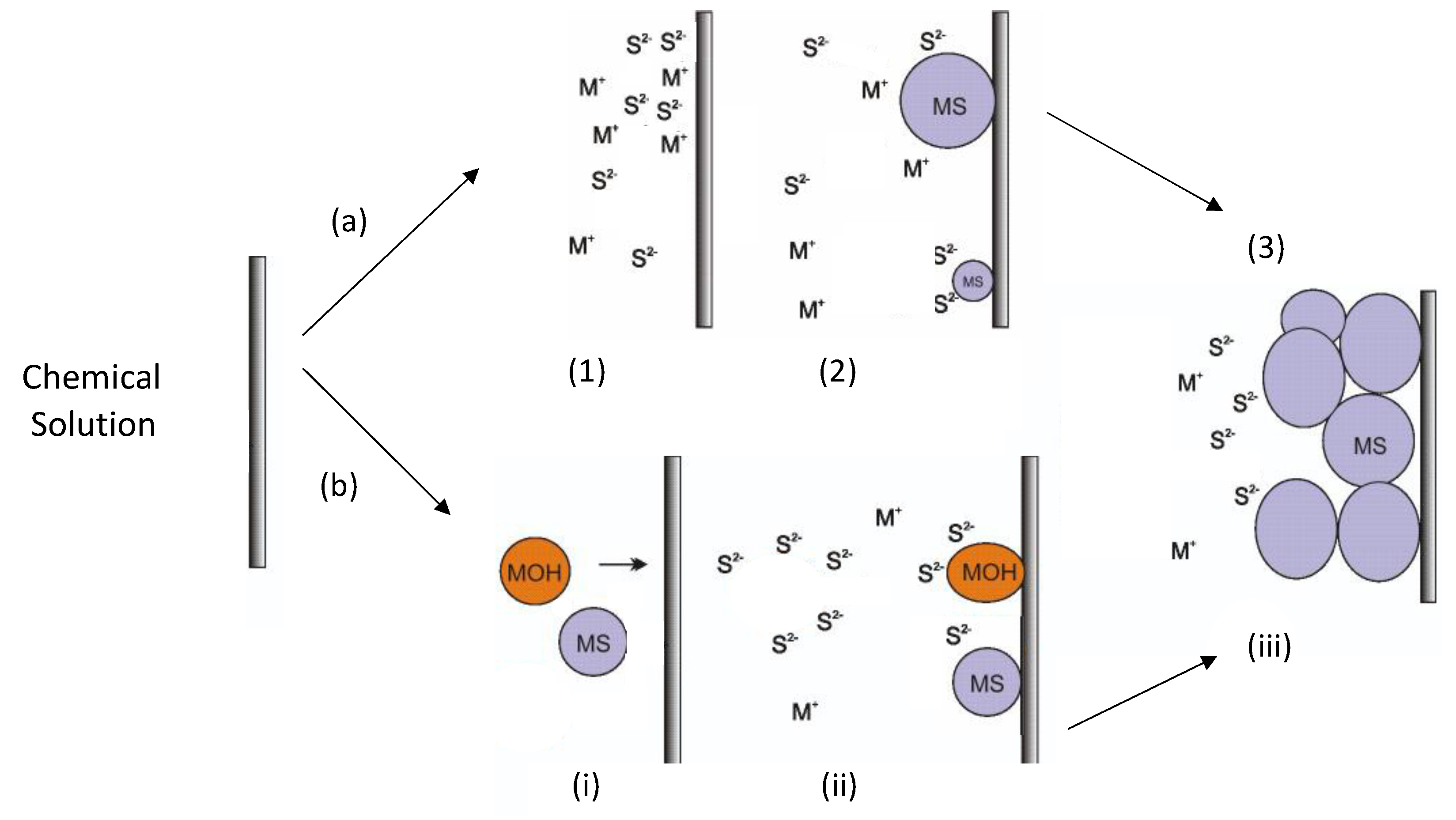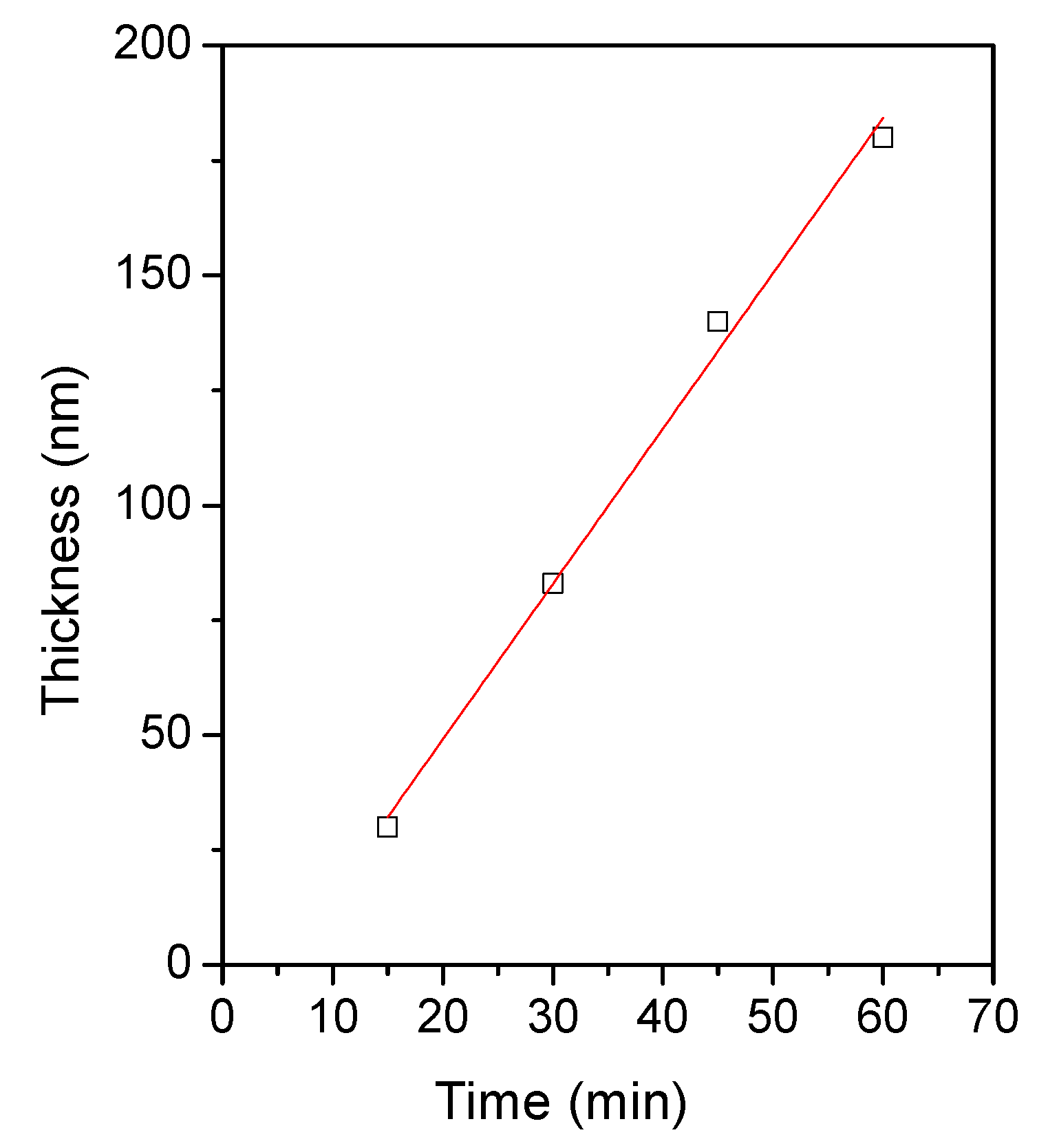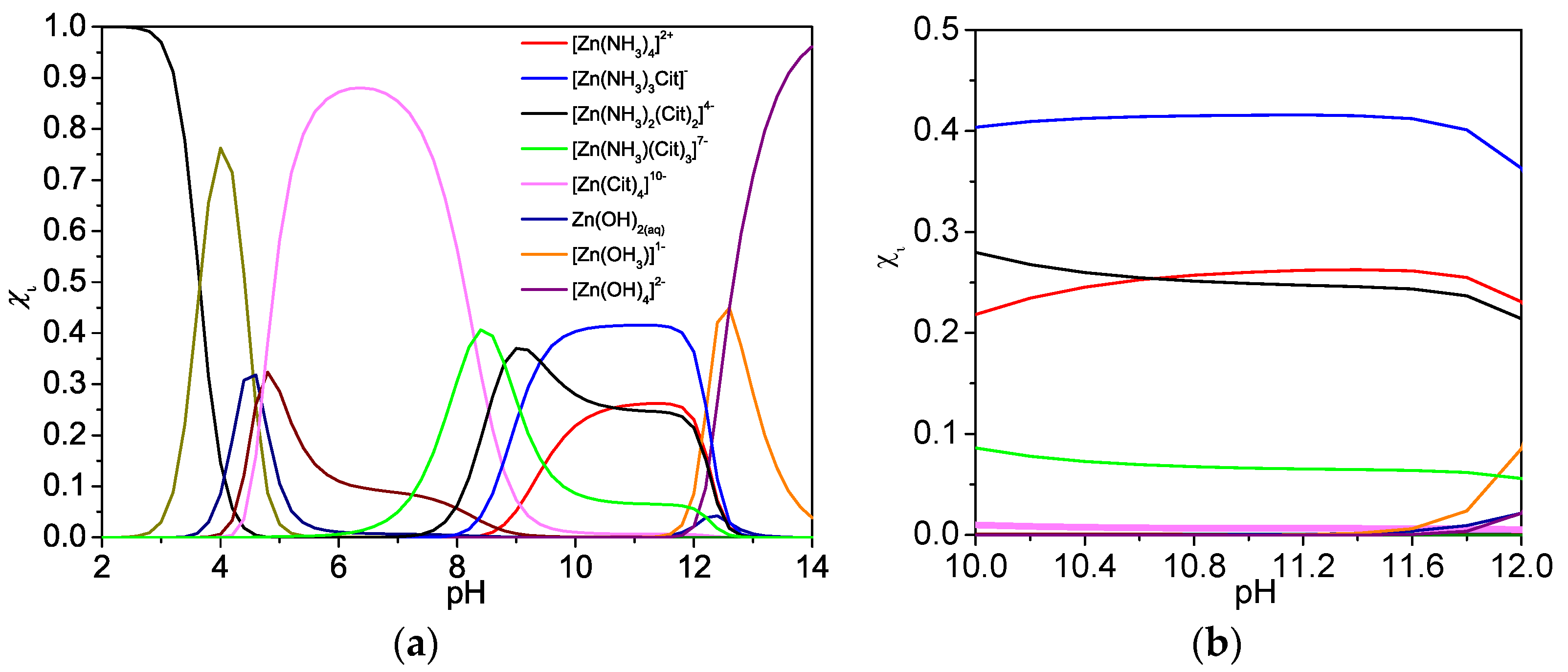Optical and Structural Characterization of Cd-Free Buffer Layers Fabricated by Chemical Bath Deposition
Abstract
1. Introduction
2. Materials and Methods
2.1. Thin Film Deposition by the CBD Process
2.2. Thin Film Characterization
3. Results and Discussion
3.1. Thin Film Depostion
3.2. Structural Characterization
3.3. Optical Characterization
4. Conclusions
Author Contributions
Funding
Institutional Review Board Statement
Informed Consent Statement
Data Availability Statement
Acknowledgments
Conflicts of Interest
References
- Vohra, K.; Vodonos, A.; Schwartz, J.; Marais, E.A.; Sulprizio, M.P.; Mickley, L.J. Global mortality from outdoor fine particle pollution generated by fossil fuel combustion: Results from GEOS-Chem. Environ. Res. 2021, 195, 110754. [Google Scholar] [CrossRef]
- Zhu, L.; Mickley, L.J.; Jacob, D.J.; Marais, E.A.; Sheng, J.; Hu, L.; Abad, G.G.; Chance, K. Long-term (2005–2014) trends in formaldehyde (HCHO) columns across North America as seen by the OMI satellite instrument: Evidence of changing emissions of volatile organic compounds. Geophys. Res. Lett. 2017, 44, 7079–7086. [Google Scholar] [CrossRef]
- Perera, F. Pollution from fossil-fuel combustion is the leading environmental threat to global pediatric health and equity: Solutions exist. Int. J. Environ. Res. Public Health 2018, 15, 16. [Google Scholar] [CrossRef] [PubMed]
- Dudley, B. BP Statistical Review of World Energy 2020; BP: London, UK, 2020. [Google Scholar]
- Martins, F.; Felgueiras, C.; Smitkova, M.; Caetano, N. Analysis of fossil fuel energy consumption and environmental impacts in european countries. Energies 2019, 12, 964. [Google Scholar] [CrossRef]
- Bebbington, J.; Schneider, T.; Stevenson, L.; Fox, A. Fossil fuel reserves and resources reporting and unburnable carbon: Investigating conflicting accounts. Crit. Perspect. Account. 2020, 66, 102083. [Google Scholar] [CrossRef]
- Ceballos, G.; Ehrlich, P.R.; Raven, P.H. Vertebrates on the brink as indicators of biological annihilation and the sixth mass extinction. Proc. Natl. Acad. Sci. USA 2020, 117, 13596–13602. [Google Scholar] [CrossRef]
- Bradshaw, C.J.A.; Ehrlich, P.R.; Beattie, A.; Ceballos, G.; Crist, E.; Diamond, J.; Dirzo, R.; Ehrlich, A.H.; Harte, J.; Harte, M.E.; et al. Underestimating the Challenges of Avoiding a Ghastly Future. Front. Conserv. Sci. 2021, 1, 615419. [Google Scholar] [CrossRef]
- REN21. Renewables 2020—Global Status Report; 2020 Update; REN21: Paris, France, 2020; ISBN 9783948393007. [Google Scholar]
- Castellanos, S.; Santibañez-Aguilar, J.E.; Shapiro, B.B.; Powell, D.M.; Peters, I.M.; Buonassisi, T.; Kammen, D.M.; Flores-Tlacuahuac, A. Sustainable silicon photovoltaics manufacturing in a global market: A techno-economic, tariff and transportation framework. Appl. Energy 2018, 212, 704–719. [Google Scholar] [CrossRef]
- Wilson, G.M.; Al-Jassim, M.; Metzger, W.K.; Glunz, S.W.; Verlinden, P.; Xiong, G.; Mansfield, L.M.; Stanbery, B.J.; Zhu, K.; Yan, Y.; et al. Exceeding 200 ns lifetimes in polycrystalline CdTe solar cells. Solar RRL 2020, 53, 493001. [Google Scholar]
- Lee, T.Y.; Lee, I.H.; Jung, S.H.; Chung, C.W. Characteristics of CdS thin films deposited on glass and Cu(In,Ga)Se2 layer using chemical bath deposition. Thin Solid Films 2013, 548, 64–68. [Google Scholar] [CrossRef]
- Merdes, S.; Malinen, V.; Ziem, F.; Lauermann, I.; Schüle, M.; Stober, F.; Hergert, F.; Papathanasiou, N.; Schlatmann, R. Zn(O,S) buffer prepared by atomic layer deposition for sequentially grown Cu(In,Ga)(Se,S)2 solar cells and modules. Sol. Energy Mater. Sol. Cells 2014, 126, 120–124. [Google Scholar] [CrossRef]
- Choubey, R.K.; Kumar, S.; Lan, C.W. Shallow chemical bath deposition of ZnS buffer layer for environmentally benign solar cell devices. Adv. Nat. Sci. Nanosci. Nanotechnol. 2014, 5, 025015. [Google Scholar] [CrossRef]
- Choi, W.J.; Park, W.W.; Kim, Y.; Son, C.S.; Hwang, D. The effect of AlD-Zn(O,S) buffer layer on the performance of CIGSSe thin film solar cells. Energies 2020, 13, 412. [Google Scholar] [CrossRef]
- Vallejo, W.; Quiñones, C.; Gordillo, G. A comparative study of thin films of Zn(O;OH)S and In(O;OH)S deposited on CuInS2 by chemical bath deposition method. J. Phys. Chem. Solids 2012, 73, 573–578. [Google Scholar] [CrossRef]
- Green, M.A.; Dunlop, E.D.; Hohl-Ebinger, J.; Yoshita, M.; Kopidakis, N.; Hao, X. Solar cell efficiency tables (version 56). Prog. Photovolt. Res. Appl. 2020, 28, 629–638. [Google Scholar] [CrossRef]
- Hong, J.; Lim, D.; Eo, Y.J.; Choi, C. Chemical bath deposited ZnS buffer layer for Cu(In,Ga)Se2 thin film solar cell. Appl. Surf. Sci. 2018, 432, 250–254. [Google Scholar] [CrossRef]
- Chen, Y.; Mei, X.; Liu, X.; Wu, B.; Yang, J.; Yang, J.; Xu, W.; Hou, L.; Qin, D.; Wang, D. Solution-processed CdTe thin-film solar cells using ZnSe nanocrystal as a buffer layer. Appl. Sci. 2018, 8, 1195. [Google Scholar] [CrossRef]
- Mughal, M.A.; Engelken, R.; Sharma, R. Progress in indium (III) sulfide (In2S3) buffer layer deposition techniques for CIS, CIGS, and CdTe-based thin film solar cells. Sol. Energy 2015, 120, 131–146. [Google Scholar] [CrossRef]
- Salomé, P.M.P.; Keller, J.; Törndahl, T.; Teixeira, J.P.; Nicoara, N.; Andrade, R.R.; Stroppa, D.G.; González, J.C.; Edoff, M.; Leitão, J.P.; et al. CdS and Zn1−xSnxOy buffer layers for CIGS solar cells. Sol. Energy Mater. Sol. Cells 2017, 159, 272–281. [Google Scholar] [CrossRef]
- Sabitha, C.; Joe, I.H.; Kumar, K.D.A.; Valanarasu, S. Investigation of structural, optical and electrical properties of ZnS thin films prepared by nebulized spray pyrolysis for solar cell applications. Opt. Quantum Electron. 2018, 50, 1–18. [Google Scholar] [CrossRef]
- Fathima, M.I.; Wilson, K.S.J. Antireflection coating application of zinc sulfide thin films by nebulizer spray pyrolysis technique. In AIP Conference Proceedings; AIP Publishing LLC: Melville, NY, USA, 2019; Volume 2115, p. 030327. [Google Scholar]
- Włodarski, M.; Chodorow, U.; Jóźwiak, S.; Putkonen, M.; Durejko, T.; Sajavaara, T.; Norek, M. Structural and optical characterization of ZnS ultrathin films prepared by low-temperature ALD from diethylzinc and 1.5-pentanedithiol after various annealing treatments. Materials 2019, 12, 3212. [Google Scholar] [CrossRef] [PubMed]
- Muchuweni, E.; Sathiaraj, T.S.; Nyakotyo, H. Synthesis and characterization of zinc oxide thin films for optoelectronic applications. Heliyon 2017, 3, e00285. [Google Scholar] [CrossRef]
- Shaban, M.; Zayed, M.; Hamdy, H. Nanostructured ZnO thin films for self-cleaning applications. RSC Adv. 2017, 7, 617–631. [Google Scholar] [CrossRef]
- Opasanont, B.; Van, K.T.; Kuba, A.G.; Choudhury, K.R.; Baxter, J.B. Adherent and conformal Zn(S,O,OH) thin films by rapid chemical bath deposition with hexamethylenetetramine additive. ACS Appl. Mater. Interfaces 2015, 7, 11516–11525. [Google Scholar] [CrossRef] [PubMed]
- Johnston, D.A.; Carletto, M.H.; Reddy, K.T.R.; Forbes, I.; Miles, R.W. Chemical bath deposition of zinc sulfide based buffer layers using low toxicity materials. In Proceedings of the Thin Solid Films; Elsevier: Amsterdam, The Netherlands, 2002; Volume 403–404, pp. 102–106. [Google Scholar]
- Memarian, N.; Rozati, S.M.; Concina, I.; Vomiero, A. Deposition of nanostructured Cds thin films by thermal evaporation method: Effect of substrate temperature. Materials 2017, 10, 773. [Google Scholar] [CrossRef]
- Kim, S.Y.; Rana, T.R.; Kim, J.H.; Yun, J.H. Cu(In,Ga)Se2 solar cells with In2S3 buffer layer deposited by thermal evaporation. J. Korean Phys. Soc. 2017, 71, 1012–1018. [Google Scholar] [CrossRef]
- Miliucci, M.; Lucci, M.; Colantoni, I.; De Matteis, F.; Micciulla, F.; Clozza, A.; Macis, S.; Davoli, I. Characterization of CdS sputtering deposition on low temperature pulsed electron deposition Cu(In,Ga)Se2 solar cells. Thin Solid Film. 2020, 697, 137833. [Google Scholar] [CrossRef]
- Ramanathan, K.; Mann, J.; Glynn, S.; Christensen, S.; Pankow, J.; Li, J.; Scharf, J.; Mansfield, L.; Contreras, M.; Noufi, R. A comparative study of Zn(O,S) buffer layers and CIGS solar cells fabricated by CBD, ALD, and sputtering. In Proceedings of the 2012 38th IEEE Photovoltaic Specialists Conference, Austin, TX, USA, 4 October 2012; pp. 1677–1680. [Google Scholar]
- Prabukanthan, P.; Harichandran, G. Electrochemical deposition of n-type ZnSe Thin Film Buffer Layer for Solar Cells. J. Electrochem. Soc. 2014, 161, D736–D741. [Google Scholar] [CrossRef]
- Palve, A.M. Deposition of zinc sulfide thin films from Zinc(II) thiosemicarbazones as single molecular precursors using aerosol assisted chemical vapor deposition technique. Front. Mater. 2019, 6, 46. [Google Scholar] [CrossRef]
- Li, J. Preparation and properties of CdS thin films deposited by chemical bath deposition. Ceram. Int. 2015, 41, S376–S380. [Google Scholar] [CrossRef]
- Maria, K.H.; Sultana, P.; Asfia, M.B. Chemical bath deposition of aluminum doped zinc sulfide thin films using non-toxic complexing agent: Effect of aluminum doping on optical and electrical properties. AIP Adv. 2020, 10, 65315. [Google Scholar] [CrossRef]
- Stumph, P.S.; Baranova, K.A.; Rogovoy, M.S.; Bunakov, V.V.; Maraeva, E.V.; Tulenin, S.S. Chemical bath deposition of In2S3 thin films as promising material and buffer layer for solar cells. In AIP Conference Proceedings; AIP Publishing LLC: Melville, NY, USA, 2019; Volume 2063, p. 040057. [Google Scholar]
- Aguilera, M.L.A.; Márquez, J.M.F.; Trujillo, M.A.G.; Kuwahara, Y.M.; Morales, G.R.; Galán, O.V. Influence of CdS thin films growth related with the substrate properties and conditions used on CBD technique. Energy Procedia 2014, 44, 111–117. [Google Scholar] [CrossRef]
- Chu, V.B.; Siopa, D.; Debot, A.; Adeleye, D.; Sood, M.; Lomuscio, A.; Melchiorre, M.; Guillot, J.; Valle, N.; El Adib, B.; et al. Waste- and Cd-free inkjet-printed Zn(O,S) buffer for Cu(In,Ga)(S,Se)2 thin-film solar cells. ACS Appl. Mater. Interfaces 2021, 13, 13009–13021. [Google Scholar] [CrossRef]
- Mugle, D.; Jadhav, G. Short review on chemical bath deposition of thin film and characterization. In AIP Conference Proceedings; AIP Publishing LLC: Melville, NY, USA, 2016; Volume 1728, p. 020597. [Google Scholar]
- Kashchiev, D. Nucleation Basic Theory with Applications, 1st ed.; Elsevier: Amsterdam, The Netherlands, 2000; ISBN 9780750646826. [Google Scholar]
- Hodes, G. Semiconductor and ceramic nanoparticle films deposited by chemical bath deposition. Phys. Chem. Chem. Phys. 2007, 9, 2181–2196. [Google Scholar] [CrossRef]
- Froment, M.; Lincot, D. Phase formation processes in solution at the atomic level: Metal chalcogenide semiconductors. Electrochim. Acta 1995, 40, 1293–1303. [Google Scholar] [CrossRef]
- Vallejo, W.; Clavijo, J.; Gordillo, G. CGS based solar cells with In2S3 buffer layer deposited by CBD and coevaporation. Braz. J. Phys. 2010, 40, 30–37. [Google Scholar] [CrossRef][Green Version]
- González-Chan, I.J.; Oliva, A.I. Physicochemical analysis and characterization of chemical bath deposited zns films at near ambient temperature. J. Electrochem. Soc. 2016, 163, D421–D427. [Google Scholar] [CrossRef]
- Goudarzi, A.; Aval, G.M.; Sahraei, R.; Ahmadpoor, H. Ammonia-free chemical bath deposition of nanocrystalline ZnS thin film buffer layer for solar cells. Thin Solid Films 2008, 516, 4953–4957. [Google Scholar] [CrossRef]
- Lǎdar, M.; Popovici, E.J.; Baldea, I.; Grecu, R.; Indrea, E. Studies on chemical bath deposited zinc sulphide thin films with special optical properties. J. Alloy. Compd. 2007, 434–435, 697–700. [Google Scholar] [CrossRef]
- Karakawa, M.; Sugahara, T.; Hirose, Y.; Suganuma, K.; Aso, Y. Thin film of amorphous zinc hydroxide semiconductor for optical devices with an energy-efficient beneficial coating by metal organic decomposition process. Sci. Rep. 2018, 8, 10839. [Google Scholar] [CrossRef] [PubMed]
- Rodríguez, C.A.; Flores, M.; Sandoval-Paz, M.; Delplancke, M.P.; Cabello-Guzmán, G.; Carrasco, C. Study of the early growth stages of chemically deposited ZnS thin films from a non-toxic solution. Mater. Res. Express 2018, 5, 076404. [Google Scholar] [CrossRef]
- Oladeji, I.O.; Chow, L. A study of the effects of ammonium salts on chemical bath deposited zinc sulfide thin films. Thin Solid Films 1999, 339, 148–153. [Google Scholar] [CrossRef]
- Wagh, A.S. Dissolution Characteristics of Metal Oxides and Kinetics of Ceramic Formation. In Chemically Bonded Phosphate Ceramics; Elsevier: Amsterdam, The Netherlands, 2016; pp. 61–73. [Google Scholar]
- Meites, L. Handbook of Analytical Chemistry, 1st ed.; McGraw-Hill: New York, NY, USA, 1963. [Google Scholar]
- Clavijo Díaz, A. Fundamentos de Química Analítica: Equilibrio Iónico y Análisis Químico; Universidad Nacional de Colombia: Bogotá, Colombia, 2002; Volume 1. [Google Scholar]
- González-Panzo, I.J.; Martín-Várguez, P.E.; Oliva, A.I. Physicochemical conditions for ZnS films deposited by chemical bath. J. Electrochem. Soc. 2014, 161, D181–D189. [Google Scholar] [CrossRef]
- Reinisch, M.; Perkins, C.L.; Steirer, K.X. Quantitative study on the chemical solution deposition of zinc oxysulfide. ECS J. Solid State Sci. Technol. 2016, 5, P58–P66. [Google Scholar] [CrossRef]
- Kim, J. Comparison of ZnS film growth on glass and CIGS substrates via hydrazine-assisted chemical bath deposition for solar cell application. Appl. Sci. Converg. Technol. 2019, 28, 229–233. [Google Scholar] [CrossRef]
- Guerrero, G.A.; Rodríguez, A.G.; Moreno-García, H. Hydrazine-free chemical bath deposition of WSe2 thin films and bi-layers for photovoltaic applications. Mater. Res. Express 2019, 6, 105906. [Google Scholar] [CrossRef]
- Zhao, H.; Liu, W.; Zhu, J.; Shen, X.; Xiong, L.; Li, Y.; Li, X.; Liu, J.; Wang, R.; Jin, C.; et al. Structural transition behavior of ZnS nanotetrapods under high pressure. High Press. Res. 2015, 35, 9–15. [Google Scholar] [CrossRef]
- Mousavi-Kamazani, M.; Zinatloo-Ajabshir, S.; Ghodrati, M. One-step sonochemical synthesis of Zn(OH)2/ZnV3O8 nanostructures as a potent material in electrochemical hydrogen storage. J. Mater. Sci. Mater. Electron. 2020, 31, 17332–17338. [Google Scholar] [CrossRef]
- Hubert, C.; Naghavi, N.; Etcheberry, A.; Roussel, O.; Hariskos, D.; Powalla, M.; Kerrec, O.; Lincot, D. A better understanding of the growth mechanism of Zn(S,O,OH) chemical bath deposited buffer layers for high efficiency Cu(In,Ga)(S,Se)2 solar cells. Phys. Status Solidi 2008, 205, 2335–2339. [Google Scholar] [CrossRef]
- Vallejo, W.; Diaz-Uribe, C.; Hurtado, M. Caracterización fisicoquímica del sistema Mo/CuInS2/Zn(O,OH)S/ZnO por medio de espectroscopía fotoelectrónica XPS y AES. Elementos 2014, 4. [Google Scholar] [CrossRef][Green Version]
- Sáez-Araoz, R.; Abou-Ras, D.; Niesen, T.P.; Neisser, A.; Wilchelmi, K.; Lux-Steiner, M.C.; Ennaoui, A. In situ monitoring the growth of thin-film ZnS/Zn(S,O) bilayer on Cu-chalcopyrite for high performance thin film solar cells. Thin Solid Film. 2009, 517, 2300–2304. [Google Scholar] [CrossRef]
- Buffière, M.; Harel, S.; Arzel, L.; Deudon, C.; Barreau, N.; Kessler, J. Fast chemical bath deposition of Zn(O,S) buffer layers for Cu(In,Ga)Se2 solar cells. Thin Solid Film. 2011, 519, 7575–7578. [Google Scholar] [CrossRef]
- Ennaoui, A.; Siebentritt, S.; Lux-Steiner, M.C.; Riedl, W.; Karg, F. High-efficiency Cd-free CIGSS thin-film solar cells with solution grown zinc compound buffer layers. Sol. Energy Mater. Sol. Cells 2001, 67, 31–40. [Google Scholar] [CrossRef]
- Platzer-Björkman, C.; Törndahl, T.; Abou-Ras, D.; Malmström, J.; Kessler, J.; Stolt, L. Zn(O,S) buffer layers by atomic layer deposition in Cu(In,Ga)Se2 based thin film solar cells: Band alignment and sulfur gradient. J. Appl. Phys. 2006, 100, 044506. [Google Scholar] [CrossRef]
- Makuła, P.; Pacia, M.; Macyk, W. How to correctly determine the band gap energy of modified semiconductor photocatalysts based on UV-Vis spectra. J. Phys. Chem. Lett. 2018, 9, 6814–6817. [Google Scholar] [CrossRef] [PubMed]
- Escobedo-Morales, A.; Ruiz-López, I.I.; Ruiz-Peralta, M.D.; Tepech-Carrillo, L.; Sánchez-Cantú, M.; Moreno-Orea, J.E. Automated method for the determination of the band gap energy of pure and mixed powder samples using diffuse reflectance spectroscopy. Heliyon 2019, 5, e01505. [Google Scholar] [CrossRef]
- Viezbicke, B.D.; Patel, S.; Davis, B.E.; Birnie, D.P. Evaluation of the tauc method for optical absorption edge determination: ZnO thin films as a model system. Phys. Status Solidi 2015, 252, 1700–1710. [Google Scholar] [CrossRef]
- Wang, L.P.; De Han, P.; Zhang, Z.X.; Zhang, C.L.; Xu, B.S. Effects of thickness on the structural, electronic, and optical properties of MgF2 thin films: The first-principles study. Comput. Mater. Sci. 2013, 77, 281–285. [Google Scholar] [CrossRef]
- Zhou, L.; Xue, Y.; Li, J. Study on ZnS thin films prepared by chemical bath deposition. J. Environ. Sci. 2009, 21, S76–S79. [Google Scholar] [CrossRef]
- Chaves, A.; Azadani, J.G.; Alsalman, H.; da Costa, D.R.; Frisenda, R.; Chaves, A.J.; Song, S.H.; Kim, Y.D.; He, D.; Zhou, J.; et al. Bandgap engineering of two-dimensional semiconductor materials. Npj 2D Mater. Appl. 2020, 4, 29. [Google Scholar] [CrossRef]
- Gong, Y.; Liu, Z.; Lupini, A.R.; Shi, G.; Lin, J.; Najmaei, S.; Lin, Z.; Elías, A.L.; Berkdemir, A.; You, G.; et al. band gap engineering and layer-by-layer mapping of selenium-doped molybdenum disulfide. Nano Lett. 2013, 14, 442–449. [Google Scholar] [CrossRef]
- Kamarulzaman, N.; Kasim, M.F.; Rusdi, R. Band gap narrowing and widening of ZnO nanostructures and doped materials. Nanoscale Res. Lett. 2015, 10, 346. [Google Scholar] [CrossRef] [PubMed]
- D’Amico, P.; Calzolari, A.; Ruini, A.; Catellani, A. New energy with ZnS: Novel applications for a standard transparent compound. Sci. Rep. 2017, 7, 16805. [Google Scholar] [CrossRef] [PubMed]
- Jiang, P.; Jie, J.; Yu, Y.; Wang, Z.; Xie, C.; Zhang, X.; Wu, C.; Wang, L.; Zhu, Z.; Luo, L. Aluminium-doped n-type ZnS nanowires as high-performance UV and humidity sensors. J. Mater. Chem. 2012, 22, 6856–6861. [Google Scholar] [CrossRef]
- Jalil, Z. Structural and optical properties of zinc oxide (ZnO) based thin films deposited by sol-gel spin coating method. J. Phys. Conf. Ser. 2018, 1116, 032020. [Google Scholar]
- Xiu, F.; Xu, J.; Joshi, P.C.; Bridges, C.A.; Paranthaman, M.P. ZnO doping and defect engineering—A review. Springer Ser. Mater. Sci. 2016, 218, 105–140. [Google Scholar]
- Lyons, J.L.; Varley, J.B.; Steiauf, D.; Janotti, A.; Walle, C.G. Van de first-principles characterization of native-defect-related optical transitions in ZnO. J. Appl. Phys. 2017, 122, 035704. [Google Scholar] [CrossRef]
- Liang, Y.-C.; Hung, C.-S.; Zhao, W.-C. Thermal annealing induced controllable porosity and photoactive performance of 2D ZnO sheets. Nanomaterials 2020, 10, 1352. [Google Scholar] [CrossRef]
- Das, N.S.; Ghosh, P.K.; Mitra, M.K.; Chattopadhyay, K.K. Effect of film thickness on the energy band gap of nanocrystalline CdS thin films analyzed by spectroscopic ellipsometry. Phys. E Low-Dimens. Syst. Nanostruct. 2010, 42, 2097–2102. [Google Scholar] [CrossRef]
- Istiaque Hossain, M.; Chelvanathan, P.; Zaman, M.; Karim, M.R.; Alghoul, M.A.; Amin, N. Prospects of indium sulphide as an alternative to cadmium sulphide buffer layer in CIS based solar cells from numerical analysis. Chalcogenide Lett. 2011, 8, 315–324. [Google Scholar]





| Number Layers | Thickness (nm) | Energy Band Gap (eV) 1 | Crystal Properties |
|---|---|---|---|
| 1 | 90 | 3.81 | Amorphous |
| 2 | 190 | 3.77 | Amorphous |
| 3 | 350 | 3.70 | Cubic/hexagonal phases |
| 4 | 480 | 3.65 | Cubic/hexagonal phases |
Publisher’s Note: MDPI stays neutral with regard to jurisdictional claims in published maps and institutional affiliations. |
© 2021 by the authors. Licensee MDPI, Basel, Switzerland. This article is an open access article distributed under the terms and conditions of the Creative Commons Attribution (CC BY) license (https://creativecommons.org/licenses/by/4.0/).
Share and Cite
Vallejo, W.; Diaz-Uribe, C.; Quiñones, C. Optical and Structural Characterization of Cd-Free Buffer Layers Fabricated by Chemical Bath Deposition. Coatings 2021, 11, 897. https://doi.org/10.3390/coatings11080897
Vallejo W, Diaz-Uribe C, Quiñones C. Optical and Structural Characterization of Cd-Free Buffer Layers Fabricated by Chemical Bath Deposition. Coatings. 2021; 11(8):897. https://doi.org/10.3390/coatings11080897
Chicago/Turabian StyleVallejo, William, Carlos Diaz-Uribe, and Cesar Quiñones. 2021. "Optical and Structural Characterization of Cd-Free Buffer Layers Fabricated by Chemical Bath Deposition" Coatings 11, no. 8: 897. https://doi.org/10.3390/coatings11080897
APA StyleVallejo, W., Diaz-Uribe, C., & Quiñones, C. (2021). Optical and Structural Characterization of Cd-Free Buffer Layers Fabricated by Chemical Bath Deposition. Coatings, 11(8), 897. https://doi.org/10.3390/coatings11080897






